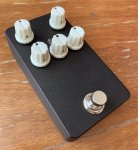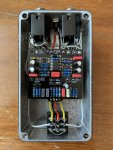I worked out how to add the bass pot rather than relying on the switches inside - not too difficult thanks to the resources online these days! So now it's built and working. I had to reorganise the pots to add the bass pot so I though why not rearrange everything so I don't get confused??
On almost all of my overdrives and distortion pedals I like to have gain top right, volume top left, bass lower left, treble lower right. If there is a midrange control I place it between the bass and treble which means removing the Tayda pot condom - some masking tape (a couple of layers) does the trick of insulation. So I rearranged the knobs which meant short wire traces around the pedal but it actually wasn't as busy as I feared.
But now I'm wondering if all the trouble was worth it! It's a bit of a strange one, this pedal. I think I can see the kind of tone they were chasing - it's very Hendrix Strat-into-Marshall sounding - well, with a Strat. Plenty of thump but the trebles sound a bit thin to me. It's a cool sound but light years away from the sound I normally head towards. As usual the board is excellent - even with all my carry on it worked flawlessly first time and didn't mind my messing it up a bit
I think I see why they made the bass adjustable with switches rather than a pot, too. Maybe it was for space, but it seems to me that the mid boost pot acts suspiciously like a bass pot as well, so you're almost doubling up. It's not really a traditional midrange control. There is no TS-style mid-hump here which is probably why the trebles seem thin. Anyway you guys with all the technical knowledge will know what is going on better than me. All I know is that the bass and mids controls are a little confusing to use.

On almost all of my overdrives and distortion pedals I like to have gain top right, volume top left, bass lower left, treble lower right. If there is a midrange control I place it between the bass and treble which means removing the Tayda pot condom - some masking tape (a couple of layers) does the trick of insulation. So I rearranged the knobs which meant short wire traces around the pedal but it actually wasn't as busy as I feared.
But now I'm wondering if all the trouble was worth it! It's a bit of a strange one, this pedal. I think I can see the kind of tone they were chasing - it's very Hendrix Strat-into-Marshall sounding - well, with a Strat. Plenty of thump but the trebles sound a bit thin to me. It's a cool sound but light years away from the sound I normally head towards. As usual the board is excellent - even with all my carry on it worked flawlessly first time and didn't mind my messing it up a bit
I think I see why they made the bass adjustable with switches rather than a pot, too. Maybe it was for space, but it seems to me that the mid boost pot acts suspiciously like a bass pot as well, so you're almost doubling up. It's not really a traditional midrange control. There is no TS-style mid-hump here which is probably why the trebles seem thin. Anyway you guys with all the technical knowledge will know what is going on better than me. All I know is that the bass and mids controls are a little confusing to use.



